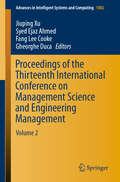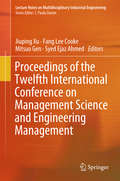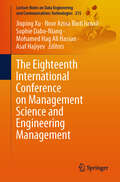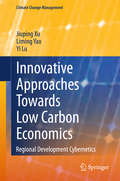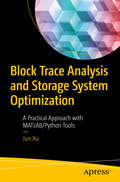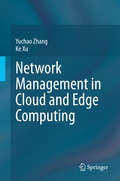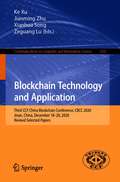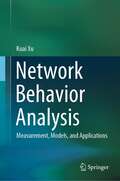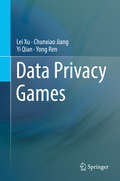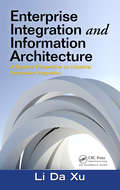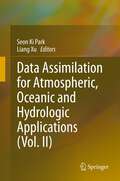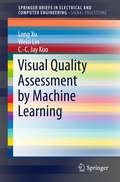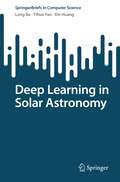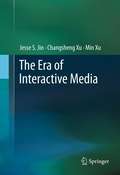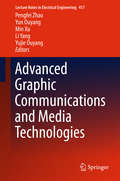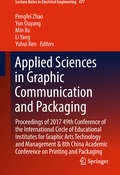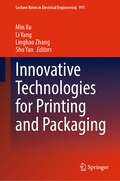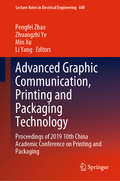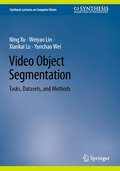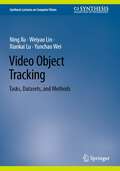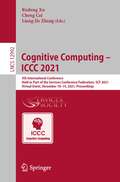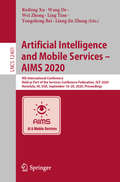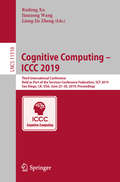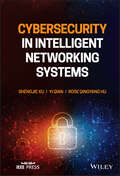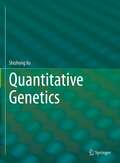- Table View
- List View
Proceedings of the Thirteenth International Conference on Management Science and Engineering Management: Volume 2 (Advances in Intelligent Systems and Computing #1002)
by Jiuping Xu Gheorghe Duca Fang Lee Cooke Syed Ejaz AhmedThis book gathers the proceedings of the 13th International Conference on Management Science and Engineering Management (ICMSEM 2019), which was held at Brock University, Ontario, Canada on August 5–8, 2019. Exploring the latest ideas and pioneering research achievements in management science and engineering management, the respective contributions highlight both theoretical and practical studies on management science and computing methodologies, and present advanced management concepts and computing technologies for decision-making problems involving large, uncertain and unstructured data. Accordingly, the proceedings offer researchers and practitioners in related fields an essential update, as well as a source of new research directions.
Proceedings of the Twelfth International Conference on Management Science and Engineering Management (Lecture Notes on Multidisciplinary Industrial Engineering)
by Jiuping Xu Mitsuo Gen Fang Lee Cooke Syed Ejaz AhmedThis proceedings book is divided in 2 Volumes and 8 Parts. Part I is dedicated to Decision Support System, which is about the information system that supports business or organizational decision-making activities; Part II is on Computing Methodology, which is always used to provide the most effective algorithm for numerical solutions of various modeling problems; Part III presents Information Technology, which is the application of computers to store, study, retrieve, transmit and manipulate data, or information in the context of a business or other enterprise; Part IV is dedicated to Data Analysis, which is a process of inspecting, cleansing, transforming, and modeling data with the goal of discovering useful information, suggesting conclusions, and supporting decision-making; Part V presents papers on Operational Management, which is about the plan, organization, implementation and control of the operation process; Part VI is on Project Management, which is about the initiating, planning, executing, controlling, and closing the work of a team to achieve specific goals and meet specific success criteria at the specified time in the field of engineering; Part VII presents Green Supply Chain, which is about the management of the flow of goods and services based on the concept of “low-carbon”; Part VIII is focused on Industry Strategy Management, which refers to the decision-making and management art of an industry or organization in a long-term and long-term development direction, objectives, tasks and policies, as well as resource allocation.
The Eighteenth International Conference on Management Science and Engineering Management (Lecture Notes on Data Engineering and Communications Technologies #215)
by Jiuping Xu Asaf Hajiyev Sophie Dabo-Niang Mohamed Hag Ali Hassan Noor Azina Binti IsmailThe proceedings of the Eighteenth ICMSEM cover a wide range of areas including hot management issues in Engineering Science. It provides newest and frontier ideas and research achievements in the area of Management Science and Engineering Management to researchers and practitioners. The work contains both theoretical and practical studies of Management Science in the Computing Methodology, showing the advanced management concepts, computing technologies for decision making problems with large, uncertain and unstructured data. Research in this proceeding will show the new changes and challenges in the decision-making procedure as we have entered the big data era. Theoretical studies of this proceedings will present the new technologies of analysis, capture, search, sharing, storage, transfer, visualization, and privacy violations, as well as advances in integration of optimization, statistics and data mining. This proceeding also contains practical studies in the real decision-making scenarios when facing large, uncertain or unstructured data. The readers who are interested in related fields of can benefit from the proceedings for the new ideas and research direction.
Innovative Approaches Towards Low Carbon Economics
by Jiuping Xu Liming Yao Yi LuClimate change is an inevitable and urgent global challenge with long-term implications for the sustainable development of all countries. To overcome this human crisis, the scientific consensus is driving global action towards low carbon economics. Though this action has to involve all sectors (industries, governments, and citizens) and at all levels (global, national and regional levels), the implementation of climate strategies will predominantly be at the regional level. By establishing an innovative range of model technologies, this book aims to develop systematic quantificational methods, such as uncertain multi-objective programming models and system dynamics models, to provide a new approach to low carbon economics that can serve as a paradigm for general regions. At the same time, it offers decision makers a number of effective strategies for some key issues in regional low carbon development, such as greenhouse gas control, ecological capacity evaluation, regional economic prediction, energy structure optimization, land resource utilization, industrial structure adjustment, low carbon industrial chains, low carbon transportation systems and low carbon tourism. It also provides researchers with a new perspective on how to address social problems using quantitative techniques.
Block Trace Analysis and Storage System Optimization: A Practical Approach with MATLAB/Python Tools
by Jun XuUnderstand the fundamental factors of data storage system performance and master an essential analytical skill using block trace via applications such as MATLAB and Python tools. You will increase your productivity and learn the best techniques for doing specific tasks (such as analyzing the IO pattern in a quantitative way, identifying the storage system bottleneck, and designing the cache policy).In the new era of IoT, big data, and cloud systems, better performance and higher density of storage systems has become crucial. To increase data storage density, new techniques have evolved and hybrid and parallel access techniques—together with specially designed IO scheduling and data migration algorithms—are being deployed to develop high-performance data storage solutions. Among the various storage system performance analysis techniques, IO event trace analysis (block-level trace analysis particularly) is one of the most common approaches for system optimization and design. However, the task of completing a systematic survey is challenging and very few works on this topic exist. Block Trace Analysis and Storage System Optimization brings together theoretical analysis (such as IO qualitative properties and quantitative metrics) and practical tools (such as trace parsing, analysis, and results reporting perspectives). The book provides content on block-level trace analysis techniques, and includes case studies to illustrate how these techniques and tools can be applied in real applications (such as SSHD, RAID, Hadoop, and Ceph systems). What You’ll Learn Understand the fundamental factors of data storage system performanceMaster an essential analytical skill using block trace via various applicationsDistinguish how the IO pattern differs in the block level from the file levelKnow how the sequential HDFS request becomes “fragmented” in final storage devicesPerform trace analysis tasks with a tool based on the MATLAB and Python platformsWho This Book Is For IT professionals interested in storage system performance optimization: network administrators, data storage managers, data storage engineers, storage network engineers, systems engineers
Network Management in Cloud and Edge Computing
by Ke Xu Yuchao ZhangTraditional cloud computing and the emerging edge computing have greatly promoted the development of Internet applications. But what are the key issues in these two trends and what are the differences between them?This book systematically introduces several key procedures in both cloud computing and edge computing scenarios, with each chapter providing a detailed description of novel design. In addition, the book also discusses a series of important findings from industry collaborations, which greatly enhance our understanding of the real system of industry. This book is not only a valuable reference resource for researchers, but also provides large-scale deployment cases for real systems in industry.In order to gain the most benefit from this book, readers should have some the basic knowledge of computer networks.
Blockchain Technology and Application: Third CCF China Blockchain Conference, CBCC 2020, Jinan, China, December 18-20, 2020, Revised Selected Papers (Communications in Computer and Information Science #1305)
by Ke Xu Jianming Zhu Xianhua Song Zeguang LuThis book constitutes the refereed proceedings of the Third CCF China Blockchain Conference, CBCC 2020, held in Jinan, China, December 2020. The 8 revised full papers presented were carefully reviewed and selected from 64 submissions. The papers deal with research results and development activities in all aspects of blockchain science and technology.
Network Behavior Analysis: Measurement, Models, and Applications
by Kuai XuThis book provides a comprehensive overview of network behavior analysis that mines Internet traffic data in order to extract, model, and make sense of behavioral patterns in Internet “objects” such as end hosts, smartphones, Internet of things, and applications. The objective of this book is to fill the book publication gap in network behavior analysis, which has recently become an increasingly important component of comprehensive network security solutions for data center networks, backbone networks, enterprise networks, and edge networks.The book presents fundamental principles and best practices for measuring, extracting, modeling and analyzing network behavior for end hosts and applications on the basis of Internet traffic data. In addition, it explains the concept and key elements (e.g., what, who, where, when, and why) of communication patterns and network behavior of end hosts and network applications, drawing on data mining, machine learning, information theory, probabilistic graphical and structural modeling to do so. The book also discusses the benefits of network behavior analysis for applications in cybersecurity monitoring, Internet traffic profiling, anomaly traffic detection, and emerging application detections.The book will be of particular interest to researchers and practitioners in the fields of Internet measurement, traffic analysis, and cybersecurity, since it provides a spectrum of innovative techniques for summarizing behavior models, structural models, and graphic models of Internet traffic, and explains how to leverage the results for a broad range of real-world applications in network management, security operations, and cyber-intelligent analysis. After finishing this book, readers will 1) have learned the principles and practices of measuring, modeling, and analyzing network behavior on the basis of massive Internet traffic data; 2) be able to make sense of network behavior for a spectrum of applications ranging from cybersecurity and network monitoring to emerging application detection; and 3) understand how to explore network behavior analysis to complement traditional perimeter-based firewall and intrusion detection systems in order to detect unusual traffic patterns or zero-day security threats using data mining and machine learning techniques. To ideally benefit from this book, readers should have a basic grasp of TCP/IP protocols, data packets, network flows, and Internet applications.
Data Privacy Games
by Lei Xu Chunxiao Jiang Yi Qian Yong RenWith the growing popularity of “big data”, the potential value of personal data has attracted more and more attention. Applications built on personal data can create tremendous social and economic benefits. Meanwhile, they bring serious threats to individual privacy. The extensive collection, analysis and transaction of personal data make it difficult for an individual to keep the privacy safe. People now show more concerns about privacy than ever before. How to make a balance between the exploitation of personal information and the protection of individual privacy has become an urgent issue.In this book, the authors use methodologies from economics, especially game theory, to investigate solutions to the balance issue. They investigate the strategies of stakeholders involved in the use of personal data, and try to find the equilibrium. The book proposes a user-role based methodology to investigate the privacy issues in data mining, identifying four different types of users, i.e. four user roles, involved in data mining applications. For each user role, the authors discuss its privacy concerns and the strategies that it can adopt to solve the privacy problems.The book also proposes a simple game model to analyze the interactions among data provider, data collector and data miner. By solving the equilibria of the proposed game, readers can get useful guidance on how to deal with the trade-off between privacy and data utility. Moreover, to elaborate the analysis on data collector’s strategies, the authors propose a contract model and a multi-armed bandit model respectively. The authors discuss how the owners of data (e.g. an individual or a data miner) deal with the trade-off between privacy and utility in data mining. Specifically, they study users’ strategies in collaborative filtering based recommendation system and distributed classification system. They built game models to formulate the interactions among data owners, and propose learning algorithms to find the equilibria.
Enterprise Integration and Information Architecture: A Systems Perspective on Industrial Information Integration (Advances In Systems Science And Engineering (asse) Ser.)
by Li Da XuEnterprise solutions have emerged as promising tools for integrating and extending business processes across business functions. Supplying a clear and comprehensive introduction to the field, this book provides a detailed description of enterprise information integration-from the development of enterprise systems to extended enterprise information
Data Assimilation for Atmospheric, Oceanic and Hydrologic Applications (Vol. II)
by Liang Xu Seon Ki ParkThis book contains the most recent progress in data assimilation in meteorology, oceanography and hydrology including land surface. It spans both theoretical and applicative aspects with various methodologies such as variational, Kalman filter, ensemble, Monte Carlo and artificial intelligence methods. Besides data assimilation, other important topics are also covered including targeting observation, sensitivity analysis, and parameter estimation. The book will be useful to individual researchers as well as graduate students for a reference in the field of data assimilation.
Visual Quality Assessment by Machine Learning
by Long Xu Weisi Lin C.-C. Jay KuoThe book encompasses the state-of-the-art visual quality assessment (VQA) and learning based visual quality assessment (LB-VQA) by providing a comprehensive overview of the existing relevant methods. It delivers the readers the basic knowledge, systematic overview and new development of VQA. It also encompasses the preliminary knowledge of Machine Learning (ML) to VQA tasks and newly developed ML techniques for the purpose. Hence, firstly, it is particularly helpful to the beginner-readers (including research students) to enter into VQA field in general and LB-VQA one in particular. Secondly, new development in VQA and LB-VQA particularly are detailed in this book, which will give peer researchers and engineers new insights in VQA.
Deep Learning in Solar Astronomy (SpringerBriefs in Computer Science)
by Long Xu Yihua Yan Xin HuangThe volume of data being collected in solar astronomy has exponentially increased over the past decade and we will be entering the age of petabyte solar data. Deep learning has been an invaluable tool exploited to efficiently extract key information from the massive solar observation data, to solve the tasks of data archiving/classification, object detection and recognition. Astronomical study starts with imaging from recorded raw data, followed by image processing, such as image reconstruction, inpainting and generation, to enhance imaging quality. We study deep learning for solar image processing. First, image deconvolution is investigated for synthesis aperture imaging. Second, image inpainting is explored to repair over-saturated solar image due to light intensity beyond threshold of optical lens. Third, image translation among UV/EUV observation of the chromosphere/corona, Ha observation of the chromosphere and magnetogram of the photosphere is realized by using GAN, exhibiting powerful image domain transfer ability among multiple wavebands and different observation devices. It can compensate the lack of observation time or waveband. In addition, time series model, e.g., LSTM, is exploited to forecast solar burst and solar activity indices. This book presents a comprehensive overview of the deep learning applications in solar astronomy. It is suitable for the students and young researchers who are major in astronomy and computer science, especially interdisciplinary research of them.
The Era of Interactive Media
by Min Xu Jesse S. Jin Changsheng XuInteractive Media is a new research field and a landmark in multimedia development. The Era of Interactive Media is an edited volume contributed from world experts working in academia, research institutions and industry. The Era of Interactive Media focuses mainly on Interactive Media and its various applications. This book also covers multimedia analysis and retrieval; multimedia security rights and management; multimedia compression and optimization; multimedia communication and networking; and multimedia systems and applications. The Era of Interactive Media is designed for a professional audience composed of practitioners and researchers working in the field of multimedia. Advanced-level students in computer science and electrical engineering will also find this book useful as a secondary text or reference.
Advanced Graphic Communications and Media Technologies (Lecture Notes in Electrical Engineering #417)
by Min Xu Li Yang Yun Ouyang Yujie Ouyang Pengfei ZhaoThis book includes a selection of reviewed papers presented at the 2016 China Academic Conference on Printing, Packaging Engineering & Media Technology, held on November 25-27, 2016 in Xi'an, China. The conference was jointly organized by China Academy of Printing Technology, Xi'an University of Technology and Stuttgart Media University of Germany. The proceedings cover the recent outcomes on color science and technology, image processing technology, digital media technology, digital process management technology in packaging and packaging etc. They will be of interest to university researchers, R&D engineers and graduate students in graphic communications, packaging, color science, image science, material science, computer science, digital media and network technology fields.
Applied Sciences in Graphic Communication and Packaging: Proceedings of 2017 49th Conference of the International Circle of Educational Institutes for Graphic Arts Technology and Management & 8th China Academic Conference on Printing and Packaging (Lecture Notes in Electrical Engineering #477)
by Min Xu Li Yang Yun Ouyang Pengfei Zhao Yuhui RenThis book includes a selection of reviewed papers presented at the 49th Conference of the International Circle of Educational Institutes for Graphic Arts Technology and Management & 8th China Academic Conference on Printing and Packaging, which was held on May 14-16, 2017 in Beijing, China. The conference was jointly organized by the Beijing Institute of Graphic Communication, China Academy of Printing Technology, and International Circle of Educational Institutes for Graphic Arts Technology and Management. With eight keynote talks and 200 presented papers on graphic communication and packaging technologies, the event attracted more than 400 scientists. The proceedings cover the latest advances in color science and technology; image processing technology; digital media technology; digital process management technology in packaging; packaging, etc. , and will be of interest to university researchers, R&D engineers and graduate students in the graphic arts, packaging, color science, image science, material science, computer science, digital media and network technology.
Innovative Technologies for Printing and Packaging (Lecture Notes in Electrical Engineering #991)
by Min Xu Li Yang Linghao Zhang Shu YanThis book includes original, peer-reviewed research papers from the 13th China Academic Conference on Printing and Packaging (CACPP 2022), held in Jinan, China, on November 10-12, 2022. The proceedings cover the recent findings in color science and technology, image processing technology, digital media technology, mechanical and electronic engineering and numerical control, materials and detection, digital process management technology in printing and packaging, and other technologies. As such, the book is of interest to university researchers, R&D engineers, and graduate students in the field of graphic arts, packaging, color science, image science, material science, computer science, digital media, network technology, and smart manufacturing technology.
Advanced Graphic Communication, Printing and Packaging Technology: Proceedings of 2019 10th China Academic Conference on Printing and Packaging (Lecture Notes in Electrical Engineering #600)
by Min Xu Li Yang Pengfei Zhao Zhuangzhi YeThis book includes a selection of peer-reviewed papers presented at the 10th China Academic Conference on Printing and Packaging, which was held in Xi'an, China, on November 14–17, 2019. The conference was jointly organized by the China Academy of Printing Technology, Beijing Institute of Graphic Communication, and Shaanxi University of Science and Technology. With 9 keynote talks and 118 papers on graphic communication and packaging technologies, the conference attracted more than 300 scientists.The proceedings cover the latest findings in a broad range of areas, including color science and technology, image processing technology, digital media technology, mechanical and electronic engineering, Information Engineering and Artificial Intelligence Technology, materials and detection, digital process management technology in printing and packaging, and other technologies. As such, the book appeals to university researchers, R&D engineers and graduate students in the graphic arts, packaging, color science, image science, material science, computer science, digital media, and network technology.
Video Object Segmentation: Tasks, Datasets, and Methods (Synthesis Lectures on Computer Vision)
by Ning Xu Weiyao Lin Xiankai Lu Yunchao WeiThis book provides a thorough overview of recent progress in video object segmentation, providing researchers and industrial practitioners with thorough information on the most important problems and developed technologies in the area. Video segmentation is a fundamental topic for video understanding in computer vision. Segmenting unique objects in a given video is useful for a variety of applications, including video conference, video editing, surveillance, and autonomous driving. Given the revolution of deep learning in computer vision problems, numerous new tasks, datasets, and methods have been recently proposed in the domain of segmentation. The book includes these recent results and findings in large-scale video object segmentation as well as benchmarks in large-scale human-centric video analysis in complex events. The authors provide readers with a comprehensive understanding of the challenges involved in video object segmentation, as well as the most effective methods for resolving them.
Video Object Tracking: Tasks, Datasets, and Methods (Synthesis Lectures on Computer Vision)
by Ning Xu Weiyao Lin Xiankai Lu Yunchao WeiThis book provides a thorough overview of recent progress in video object tracking, allowing researchers and industrial practitioners to gain a better understanding of the most important problems and developed technologies in the area. Video tracking is a key research area in computer vision and aims to track unique objects in a given video, which are useful for various applications such as video conference, video editing, surveillance, and autonomous driving. This book begins with an introduction to the task of video object tracking, including the most common problem settings. Given the revolution of deep learning in computer vision problems, numerous new tasks, datasets, and methods have been recently proposed in the domain of video tracking. The book includes these recent results as well as benchmarks in large-scale human-centric video analysis in complex events.
Cognitive Computing – ICCC 2021: 5th International Conference, Held as Part of the Services Conference Federation, SCF 2021, Virtual Event, December 10–14, 2021, Proceedings (Lecture Notes in Computer Science #12992)
by Ruifeng Xu Cheng Cai Liang-Jie ZhangThis book constitutes the proceedings of the International Conference on Cognitive Computing, ICCC 2021, held as part of SCF 2021 in December 2021. The conference was held virtually due to the COVID-19 pandemic. The 5 full and 3 short papers presented in this volume were carefully reviewed and selected from 31 submissions. The papers cover all aspects of Sensing Intelligence (SIJ as a Service (SlaaS). Cognitive Computing is a sensing-driven computing (SDC) scheme that explores and integrates intelligence from all types of senses in various scenarios and solution contexts.
Artificial Intelligence and Mobile Services – AIMS 2020: 9th International Conference, Held as Part of the Services Conference Federation, SCF 2020, Honolulu, HI, USA, September 18-20, 2020, Proceedings (Lecture Notes in Computer Science #12401)
by Ruifeng Xu Wang De Wei Zhong Ling Tian Yongsheng Bai Liang-Jie ZhangThis book constitutes the proceedings of the 9th International Conference on Artificial Intelligence and Mobile Services, AIMS 2020, held as part of SCF 2020, during September 18-20, 2020. The conference was planned to take place in Honolulu, HI, USA and was changed to a virtual format due to the COVID-19 pandemic. The 11 full and 2 short papers presented were carefully reviewed and selected from 42 submissions. They cover topics in AI Modeling, AI Analysis, AI and Mobile Applications, AI Architecture, AI Management, AI Engineering, Mobile backend as a service (MBaaS), User experience of AI and mobile services.
Cognitive Computing – ICCC 2019: Third International Conference, Held as Part of the Services Conference Federation, SCF 2019, San Diego, CA, USA, June 25–30, 2019, Proceedings (Lecture Notes in Computer Science #11518)
by Ruifeng Xu Jianzong Wang Liang-Jie ZhangThis book constitutes the proceedings of the International Conference on Cognitive Computing, ICCC 2019, held as part of SCF 2019, in San Diego, CA, USA, in June 2019. The 14 full and 3 short papers presented in this volume were carefully reviewed and selected from 42 submissions. The papers cover all aspects of Sensing Intelligence (SIJ as a Service (SlaaS). Cognitive Computing is a sensing-driven computing (SDC) scheme that explores and integrates intelligence from all types of senses in various scenarios and solution contexts
Cybersecurity in Intelligent Networking Systems (IEEE Press)
by Shengjie Xu Yi Qian Rose Qingyang HuCYBERSECURITY IN INTELLIGENT NETWORKING SYSTEMS Help protect your network system with this important reference work on cybersecurity Cybersecurity and privacy are critical to modern network systems. As various malicious threats have been launched that target critical online services—such as e-commerce, e-health, social networks, and other major cyber applications—it has become more critical to protect important information from being accessed. Data-driven network intelligence is a crucial development in protecting the security of modern network systems and ensuring information privacy. Cybersecurity in Intelligent Networking Systems provides a background introduction to data-driven cybersecurity, privacy preservation, and adversarial machine learning. It offers a comprehensive introduction to exploring technologies, applications, and issues in data-driven cyber infrastructure. It describes a proposed novel, data-driven network intelligence system that helps provide robust and trustworthy safeguards with edge-enabled cyber infrastructure, edge-enabled artificial intelligence (AI) engines, and threat intelligence. Focusing on encryption-based security protocol, this book also highlights the capability of a network intelligence system in helping target and identify unauthorized access, malicious interactions, and the destruction of critical information and communication technology. Cybersecurity in Intelligent Networking Systems readers will also find: Fundamentals in AI for cybersecurity, including artificial intelligence, machine learning, and security threats Latest technologies in data-driven privacy preservation, including differential privacy, federated learning, and homomorphic encryption Key areas in adversarial machine learning, from both offense and defense perspectives Descriptions of network anomalies and cyber threats Background information on data-driven network intelligence for cybersecurity Robust and secure edge intelligence for network anomaly detection against cyber intrusions Detailed descriptions of the design of privacy-preserving security protocols Cybersecurity in Intelligent Networking Systems is an essential reference for all professional computer engineers and researchers in cybersecurity and artificial intelligence, as well as graduate students in these fields.
Quantitative Genetics
by Shizhong XuThe intended audience of this textbook are plant and animal breeders, upper-level undergraduate and graduate students in biological and agricultural science majors. Statisticians who are interested in understanding how statistical methods are applied to genetics and agriculture can benefit substantially by reading this book. One characteristic of this textbook is represented by three chapters of technical reviews for Mendelian genetics, population genetics and preliminary statistics, which are prerequisites for studying quantitative genetics. Numerous examples are provided to illustrate different methods of data analysis and estimation of genetic parameters. Along with each example of data analyses is the program code of SAS (statistical analysis system).
